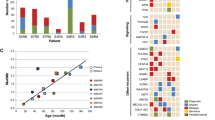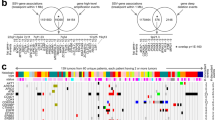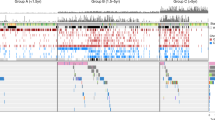Abstract
Neuroblastomas are tumors of peripheral sympathetic neurons and are the most common solid tumor in children. To determine the genetic basis for neuroblastoma, we performed whole-genome sequencing (6 cases), exome sequencing (16 cases), genome-wide rearrangement analyses (32 cases) and targeted analyses of specific genomic loci (40 cases) using massively parallel sequencing. On average, each tumor had 19 somatic alterations in coding genes (range of 3–70). Among genes not previously known to be involved in neuroblastoma, chromosomal deletions and sequence alterations of the chromatin-remodeling genes ARID1A and ARID1B were identified in 8 of 71 tumors (11%) and were associated with early treatment failure and decreased survival. Using tumor-specific structural alterations, we developed an approach to identify rearranged DNA fragments in sera, providing personalized biomarkers for minimal residual disease detection and monitoring. These results highlight the dysregulation of chromatin remodeling in pediatric tumorigenesis and provide new approaches for the management of patients with neuroblastoma.
This is a preview of subscription content, access via your institution
Access options
Subscribe to this journal
Receive 12 print issues and online access
$209.00 per year
only $17.42 per issue
Buy this article
- Purchase on Springer Link
- Instant access to full article PDF
Prices may be subject to local taxes which are calculated during checkout



Similar content being viewed by others
Accession codes
References
Ries, L.A.G. et al. Cancer Incidence and Survival among Children and Adolescents: United States SEER Program 1975–1995 (National Cancer Institute, SEER Program, Bethesda, Maryland, 1999).
Maris, J.M. Recent advances in neuroblastoma. N. Engl. J. Med. 362, 2202–2211 (2010).
Maris, J.M., Hogarty, M.D., Bagatell, R. & Cohn, S.L. Neuroblastoma. Lancet 369, 2106–2120 (2007).
Capasso, M. & Diskin, S.J. Genetics and genomics of neuroblastoma. Cancer Treat. Res. 155, 65–84 (2010).
Mueller, S. & Matthay, K.K. Neuroblastoma: biology and staging. Curr. Oncol. Rep. 11, 431–438 (2009).
Schwab, M. et al. Amplified DNA with limited homology to myc cellular oncogene is shared by human neuroblastoma cell lines and a neuroblastoma tumour. Nature 305, 245–248 (1983).
Brodeur, G.M. & Seeger, R.C. Gene amplification in human neuroblastomas: basic mechanisms and clinical implications. Cancer Genet. Cytogenet. 19, 101–111 (1986).
Chen, Y. et al. Oncogenic mutations of ALK kinase in neuroblastoma. Nature 455, 971–974 (2008).
George, R.E. et al. Activating mutations in ALK provide a therapeutic target in neuroblastoma. Nature 455, 975–978 (2008).
Janoueix-Lerosey, I. et al. Somatic and germline activating mutations of the ALK kinase receptor in neuroblastoma. Nature 455, 967–970 (2008).
Mossé, Y.P. et al. Identification of ALK as a major familial neuroblastoma predisposition gene. Nature 455, 930–935 (2008).
Cheung, N.K. et al. Association of age at diagnosis and genetic mutations in patients with neuroblastoma. J. Am. Med. Assoc. 307, 1062–1071 (2012).
Parsons, D.W. et al. The genetic landscape of the childhood cancer medulloblastoma. Science 331, 435–439 (2011).
Jones, S. et al. Core signaling pathways in human pancreatic cancers revealed by global genomic analyses. Science 321, 1801–1806 (2008).
Sjöblom, T. et al. The consensus coding sequences of human breast and colorectal cancers. Science 314, 268–274 (2006).
Molenaar, J.J. et al. Sequencing of neuroblastoma identifies chromothripsis and defects in neuritogenesis genes. Nature 483, 589–593 (2012).
Clark, M.J. et al. Performance comparison of exome DNA sequencing technologies. Nat. Biotechnol. 29, 908–914 (2011).
Viswanathan, S.R. et al. Lin28 promotes transformation and is associated with advanced human malignancies. Nat. Genet. 41, 843–848 (2009).
Cotterman, R. & Knoepfler, P.S. N-Myc regulates expression of pluripotency genes in neuroblastoma including lif, klf2, klf4, and lin28b. PLoS ONE 4, e5799 (2009).
Rikova, K. et al. Global survey of phosphotyrosine signaling identifies oncogenic kinases in lung cancer. Cell 131, 1190–1203 (2007).
Soda, M. et al. Identification of the transforming EML4-ALK fusion gene in non-small-cell lung cancer. Nature 448, 561–566 (2007).
Hogarty, M.D. et al. ODC1 is a critical determinant of MYCN oncogenesis and a therapeutic target in neuroblastoma. Cancer Res. 68, 9735–9745 (2008).
Wang, X. et al. Two related ARID family proteins are alternative subunits of human SWI/SNF complexes. Biochem. J. 383, 319–325 (2004).
Fujimoto, A. et al. Whole-genome sequencing of liver cancers identifies etiological influences on mutation patterns and recurrent mutations in chromatin regulators. Nat. Genet. 44, 760–764 (2012).
Stephens, P.J. et al. The landscape of cancer genes and mutational processes in breast cancer. Nature 486, 400–404 (2012).
Jones, S. et al. Frequent mutations of chromatin remodeling gene ARID1A in ovarian clear cell carcinoma. Science 330, 228–231 (2010).
Jones, D.T. et al. Dissecting the genomic complexity underlying medulloblastoma. Nature 488, 100–105 (2012).
Pugh, T.J. et al. Medulloblastoma exome sequencing uncovers subtype-specific somatic mutations. Nature 488, 106–110 (2012).
Versteege, I. et al. Truncating mutations of hSNF5/INI1 in aggressive paediatric cancer. Nature 394, 203–206 (1998).
Varela, I. et al. Exome sequencing identifies frequent mutation of the SWI/SNF complex gene PBRM1 in renal carcinoma. Nature 469, 539–542 (2011).
Gui, Y. et al. Frequent mutations of chromatin remodeling genes in transitional cell carcinoma of the bladder. Nat. Genet. 43, 875–878 (2011).
Pasqualucci, L. et al. Inactivating mutations of acetyltransferase genes in B-cell lymphoma. Nature 471, 189–195 (2011).
Jiao, Y. et al. DAXX/ATRX, MEN1, and mTOR pathway genes are frequently altered in pancreatic neuroendocrine tumors. Science 331, 1199–1203 (2011).
Schwartzentruber, J. et al. Driver mutations in histone H3.3 and chromatin remodelling genes in paediatric glioblastoma. Nature 482, 226–231 (2012).
Wu, G. et al. Somatic histone H3 alterations in pediatric diffuse intrinsic pontine gliomas and non-brainstem glioblastomas. Nat. Genet. 44, 251–253 (2012).
Robinson, G. et al. Novel mutations target distinct subgroups of medulloblastoma. Nature 488, 43–48 (2012).
Leary, R.J. et al. Development of personalized tumor biomarkers using massively parallel sequencing. Sci. Transl. Med. 2, 20ra14 (2010).
Combaret, V. et al. Circulating MYCN DNA as a tumor-specific marker in neuroblastoma patients. Cancer Res. 62, 3646–3648 (2002).
Yu, A.L. et al. Anti-GD2 antibody with GM-CSF, interleukin-2, and isotretinoin for neuroblastoma. N. Engl. J. Med. 363, 1324–1334 (2010).
Diehl, F. et al. Circulating mutant DNA to assess tumor dynamics. Nat. Med. 14, 985–990 (2008).
Ho, L. & Crabtree, G.R. Chromatin remodelling during development. Nature 463, 474–484 (2010).
Ichimura, K. et al. Small regions of overlapping deletions on 6q26 in human astrocytic tumours identified using chromosome 6 tile path array-CGH. Oncogene 25, 1261–1271 (2006).
Capasso, M. et al. Common variations in BARD1 influence susceptibility to high-risk neuroblastoma. Nat. Genet. 41, 718–723 (2009).
Wang, K. et al. Integrative genomics identifies LMO1 as a neuroblastoma oncogene. Nature 469, 216–220 (2011).
Knudson, A.G. Jr., Meadows, A.T., Nichols, W.W. & Hill, R. Chromosomal deletion and retinoblastoma. N. Engl. J. Med. 295, 1120–1123 (1976).
Wu, J. et al. Whole-exome sequencing of neoplastic cysts of the pancreas reveals recurrent mutations in components of ubiquitin-dependent pathways. Proc. Natl. Acad. Sci. USA 108, 21188–21193 (2011).
Bettegowda, C. et al. Mutations in CIC and FUBP1 contribute to human oligodendroglioma. Science 333, 1453–1455 (2011).
Wu, J. et al. Recurrent GNAS mutations define an unexpected pathway for pancreatic cyst development. Sci. Transl. Med. 3, 92ra66 (2011).
Agrawal, N. et al. Exome sequencing of head and neck squamous cell carcinoma reveals inactivating mutations in NOTCH1. Science 333, 1154–1157 (2011).
1000 Genomes Project Consortium. A map of human genome variation from population-scale sequencing. Nature 467, 1061–1073 (2010).
Kent, W.J. BLAT—the BLAST-like alignment tool. Genome Res. 12, 656–664 (2002).
Wang, Q. et al. Integrative genomics identifies distinct molecular classes of neuroblastoma and shows that multiple genes are targeted by regional alterations in DNA copy number. Cancer Res. 66, 6050–6062 (2006).
Benjamini, Y. & Hochberg, Y. Controlling the false discovery rate—a practical and powerful approach to multiple testing. J. R. Stat. Soc. B 57, 289–300 (1995).
Acknowledgements
We thank the families and children with neuroblastoma who contributed to this work. We thank J. Maris for valuable input to this work, J. Ptak, N. Silliman, L. Dobbyn, M. Whalen, J. Schaefer and T. Mosbruger for technical assistance with sequencing analyses, L. Kann and S. Angiuoli of Personal Genome Diagnostics for targeted sequence analyses, the Children's Oncology Group (COG), W.B. London and the COG Statistics and Data Center, J. Gastier-Foster and the Neuroblastoma Reference Laboratory, N. Ramirez and the Biopathology Center, C. Winter and the Children's Hospital of Philadelphia (CHOP) Nucleic Acids Bank, and T. Woodburn and the COG Cell Line Repository. This work was generously supported by the St. Baldrick's Foundation for childhood cancer research, the Virginia and D.K. Ludwig Fund for Cancer Research, Swim Across America, an American Association for Cancer Research (AACR) Stand Up To Cancer–Dream Team Translational Cancer Research Grant and US National Institutes of Health (NIH) grant CA121113.
Author information
Authors and Affiliations
Contributions
C.P.R. established cell lines, and C.P.R. and X.L. purified DNA samples from which M.S. prepared next-generation DNA sequencing libraries. J.W. performed MYCN capture of genomic DNA libraries for massively parallel sequencing. M.S. and R.J.L. analyzed sequencing data for structural alterations. M.S., S.J., N.P., B.V., K.W.K. and V.E.V. sequenced next-generation DNA libraries and performed mutational analyses. A.B., G.P. and L.A.D. performed statistical analyses of clinical and sequencing data. M.S., R.J.L., B.V., K.W.K., V.E.V. and M.D.H. conceived the research and wrote the manuscript.
Corresponding authors
Ethics declarations
Competing interests
L.A.D., N.P., B.V., K.W.K. and V.E.V. are founders of Inostics and Personal Genome Diagnostics and are members of their Scientific Advisory Boards. L.A.D., N.P., B.V., K.W.K. and V.E.V. own Inostics and Personal Genome Diagnostics stock, which is subject to certain restrictions under university policy. The terms of these arrangements are managed by Johns Hopkins University in accordance with its conflict-of-interest policies.
Supplementary information
Supplementary Text and Figures
Supplementary Figures 1–4, Supplementary Tables 2–4 and 8–10 and Supplementary Note (PDF 900 kb)
Supplementary Table 1
Description of neuroblastoma samples analyzed (XLSX 29 kb)
Supplementary Table 5
Somatic mutations identified in neuroblastoma (XLSX 37 kb)
Supplementary Table 6
Copy number alterations identified in neuroblastoma (XLSX 36 kb)
Supplementary Table 7
Somatic rearrangements identified in neuroblastoma (XLSX 43 kb)
Rights and permissions
About this article
Cite this article
Sausen, M., Leary, R., Jones, S. et al. Integrated genomic analyses identify ARID1A and ARID1B alterations in the childhood cancer neuroblastoma. Nat Genet 45, 12–17 (2013). https://doi.org/10.1038/ng.2493
Received:
Accepted:
Published:
Issue Date:
DOI: https://doi.org/10.1038/ng.2493
This article is cited by
-
Multimodal immunogenomic biomarker analysis of tumors from pediatric patients enrolled to a phase 1-2 study of single-agent atezolizumab
Nature Cancer (2023)
-
ARID1A mutation associated with recurrence and shorter progression-free survival in atypical meningiomas
Journal of Cancer Research and Clinical Oncology (2023)
-
Genomic ALK alterations in primary and relapsed neuroblastoma
British Journal of Cancer (2023)
-
Defining the landscape of circular RNAs in neuroblastoma unveils a global suppressive function of MYCN
Nature Communications (2023)
-
Roles of ARID1A variations in colorectal cancer: a collaborative review
Molecular Medicine (2022)



